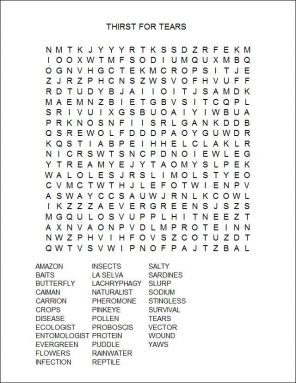These insects thirst for tears
Scientists are curious about ‘tear-sucking,’ an unusual and little-studied bug behavior
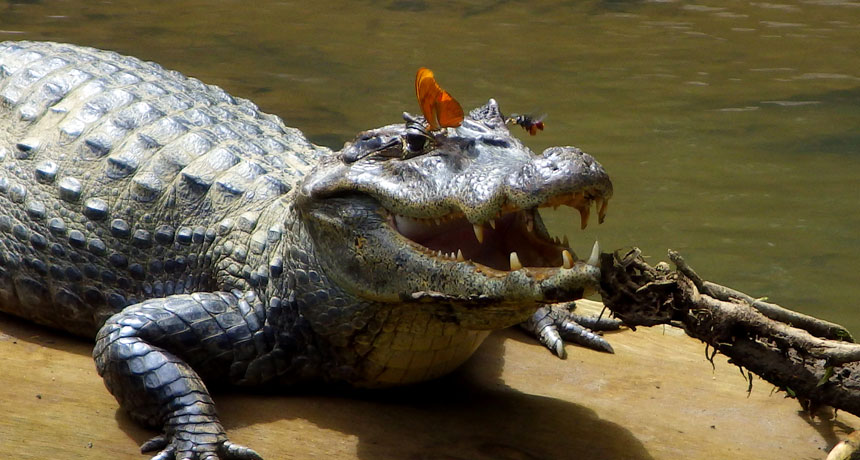
A Costa Rican nature tableau: Insects feeding from the eyes of a basking caiman.
C. de la Rosa
By Janet Raloff
Much of early science consisted of people observing the world around them — and then trying to puzzle out why things happen the way they do. That approach, common thousands of years ago, still goes on in some areas of biology today. And here’s one example: Biologists have lately begun noticing — and wondering why — some insects have a thirst for the tears of big animals, including people.
Carlos de la Rosa is an aquatic ecologist and director of the La Selva Biological Station in Costa Rica, where it’s part of the Organization for Tropical Studies. Last December, he and some co-workers had a hard time taking their eyes off of a spectacled caiman (Caiman crocodilus). It was basking on a log near their office. The croc-like animal’s presence wasn’t what surprised them. What did were the butterfly and bee drinking liquid from the reptile’s eyes. The caiman, though, didn’t seem to care, de la Rosa reports in the May Frontiers in Ecology and the Environment.
“It was one of those natural history moments that you long to see up close,” he says. “But then the question becomes, what’s going on here? Why are these insects tapping into this resource?”
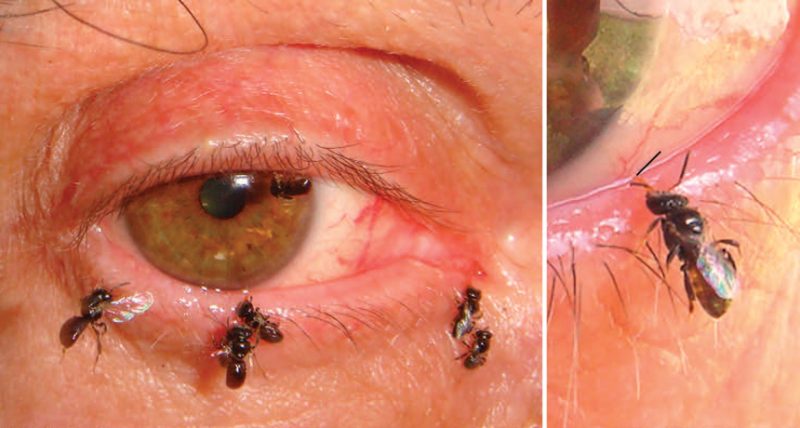
After snapping photos of the event, de la Rosa went back to his office. There he began a Google search to investigate how common tear-sipping might be. It happens often enough that there’s a scientific term for this behavior: lachryphagy (LAK-rih-fah-gee). And the more de la Rosa looked, the more reports he turned up.
In October 2012, for example, in the same journal de la Rosa has just published in, Frontiers in Ecology and the Environment, ecologists documented bees drinking the tears of a river turtle. Olivier Dangles of the Pontifical Catholic University of Ecuador and Jérôme Casas of the University of Tours in France, had traveled through creeks in Ecuador until they reached Yasuní National Park. It lies in the Amazon jungle. This place was “every naturalist’s dream,” they said. Amazing animals were on view everywhere, including a harpy eagle, jaguar and endangered giant otter. Still, “our most memorable experience,” they said, were those tear-sucking bees.
It turns out that lachryphagy is fairly common. There are plenty of scattered reports of butterflies, bees and other insects performing this behavior. What isn’t as clear, though, is the science to establish why the tiny beasts do it. But some scientists have turned up strong clues.

Bee-deviled by stingless sippers
One of the most detailed looks into tear-feeding comes from Hans Bänziger’s team at Chiang Mai University in Thailand. Bänziger first noticed the behavior in stingless bees. He was working at the tops of Thai trees, studying how flowers way up there were being pollinated. Strangely, he observed, two species of Lisotrigona bees bugged his eyes — but never landed on the trees’ blooms. Back at ground level, those bees still preferred visiting his eyes, not flowers.
Curious to know more, his team launched a year-long study. They stopped by 10 sites throughout Thailand. They studied dry and wet sites, at high and low elevations, in evergreen forests and floral gardens. At half of the sites, they put out seven smelly baits that they knew many bees like — such as steamed sardines, salted and sometimes smoked fish, smoked ham, cheese, fresh pork, old meat (not yet rotted) and the Ovaltine powder used to make cocoa. Then they watched for hours. Many stingless bees visited the baits — but none of the type that had shown a preference for tear-sipping.
Still, tear-drinking bees were present. Team leader Bänziger volunteered to be the primary guinea pig, allowing more than 200 interested bees to sip from his eyes. His team recounted the bees’ behavior in a 2009 paper in the Journal of the Kansas Entomological Society. In general, they noted, these bees first size up the eyes as they fly about the head, them home in on their target. After landing on the lashes and grabbing hold to keep from falling off, a bee crawls toward the eye. There it plunges its straw-like mouthpiece — or proboscis — into the gutter-like trough between the lower lid and eyeball. “In rare cases a foreleg was placed onto the eye ball, and in one case the bee even climbed onto it with all legs,” the scientists wrote.
It didn’t hurt, Bänziger reported. In some cases a bee was so gentle he wasn’t sure if it had left until he used a mirror for confirmation. But when multiple bees came for a joint drink-fest, which might last an hour or more, things could turn itchy. Bees sometimes cycled in to take the place of a departing bug. Several insects might line up in a row, each slurping up tears for several minutes. Afterward, Bänziger’s eye sometimes stayed red and irritated for more than a day.
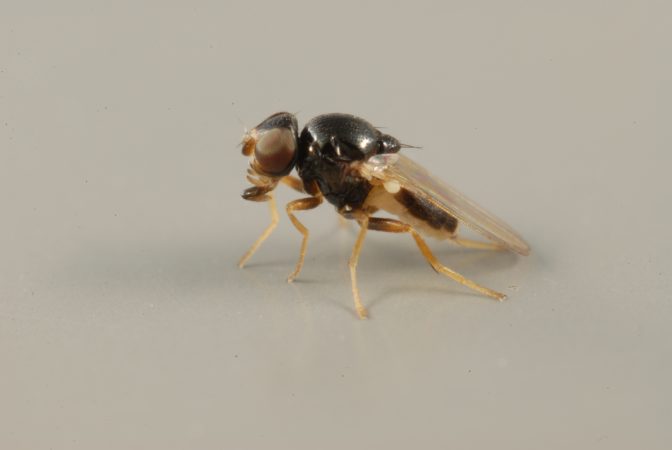
The bees didn’t have to try all that hard to find the eye juice they sought. Bänziger said he could smell a pheromone — a chemical attractant released the bees — that soon lured in more of the bugs. And human eyes appeared to be a real treat for the tiny buzzers. When a dog ambled by during one testing session, the bees sampled its tears. However, the researchers reported, “we continued to be the main attraction even in the presence of the dog and for a good hour after it left.”
The eyes of lots of non-human animals have proven plenty alluring to tear-drinking insects, though. Hosts have included cows, horses, oxen, deer, elephants, caimans, turtles and two species of birds, according to scientific reports. And it’s not just bees lapping up moisture from animal eyes. There are tear-sipping moths, butterflies, flies and other insects that occur throughout much of the world.
Why do the insects do it?
Everyone knows tears are salty, so it’s easy to assume the insects are looking for a salt fix. Indeed, Dangles and Casas note in their report, sodium — a prime ingredient in salt — “is an essential nutrient for the survival and reproduction of living organisms.” It helps maintain blood volume and allows cells to stay moist. Sodium even keeps nerves working properly. But because plants tend to be relatively low in salt, plant eating insects may need to seek out extra salt by turning to tears, sweat or — and this is gross — animal feces and dead bodies.
Still, it’s likely that the primary draw of tears for these insects is its protein, Bänziger believes. He has found that tears are a rich source of it. These tiny droplets can have 200 times more protein than an equal amount of sweat, another source of salt.
The tear-sipping insects may have need for that protein. Among bees, for instance, Bänziger’s group has noted that “tear drinkers rarely carried pollen.” These bees also showed little interest in flowers. And they had few leg hairs, which other types of bees use to pick up pollen and carry it home. That would “seem to support the importance of tears as protein sources,” the scientists argued.
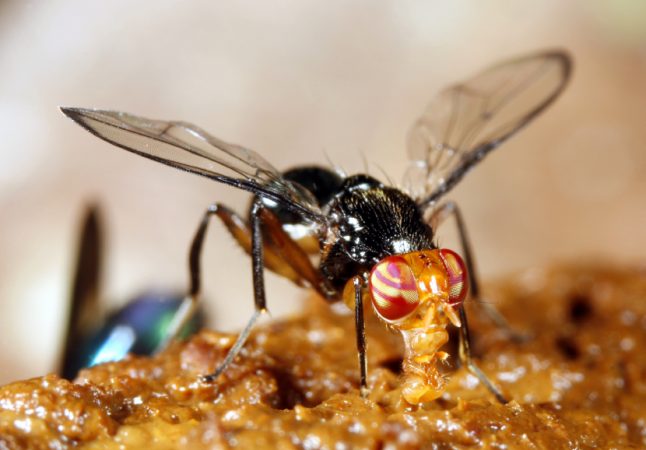
Many other insects, including stingless bees in the Trigona genus, pick up protein by dining on carrion (dead animals). They often have well-developed mouth parts that can cut into flesh and chew it up. They then partly predigest the meat before slurping it up and into their crops. Those are throat-like storage structures with which they can carry this meal back to their nest.
The tear-sipping stingless bees don’t have those sharp mouthparts. But Bänziger’s team found the insects completely fill their crops with protein-rich tears. The back part of their body extends and swells to hold their haul. The researchers suspect that once these bees return home, they will release the fluid “into storage pots or to receiver bees.” Those receivers can then process the tears and provide protein-rich food to others in their colony.
And the risks
Insects, including ones that drink tears, can pick up germs while visiting one host and carry them to another, notes Jerome Goddard. As a medical entomologist at Mississippi State, he studies the role of insects in disease.
“We see this in hospitals,” he tells Science News for Students. “Flies, ants or cockroaches pick up germs from the floor or maybe a sewer. And then they come up to a patient and walk on their face or in a wound.” Yes, there’s the yuck factor. But more worryingly, these insects can move around the germs that cause serious disease.
It’s something veterinarians have witnessed. They have found insects that transfer disease from the eye of one animal to that of another, Goddard notes. In a pasture, housefly-like “face flies” can transmit pinkeye between the eyes of cows. Those insects transfer the bacteria that cause the eye infection. Similarly, a tiny fly known as the eye gnat plagues many dogs. In some parts of the world, he says, this Liohippelates fly can even transmit a bacterial infection called yaws between animals and people.
The good news: No one on Bänziger’s team has gotten sick from the bees that have drunk their tears. The scientists say this may be because the bees are so tiny that they don’t travel far. So they don’t have much opportunity to acquire diseases that could harm people.
Goddard, too, learned of no diseases spread by butterflies and moths. But that doesn’t mean he isn’t worried. Keep in mind, he says, some of these insects seek out puddles to slake their thirst. And if the puddle contains not just rainwater but the bodily fluids leaking from some dead animal, hordes of germs could be present. On the next stop that moth or butterfly takes, it could drop off some of those germs.
That’s what concerns him when he hears about tear-drinking bugs: Where were those insects before they landed on a face and started crawling up towards the eyes?
Power Words
amino acids Simple molecules that occur naturally in plant and animal tissues and that are the basic constituents of proteins
aquatic An adjective that refers to water.
bacterium (pluralbacteria) A single-celled organism forming one of the three domains of life. These dwell nearly everywhere on Earth, from the bottom of the sea to inside animals.
bug The slang term for an insect. Sometimes it’s even used to refer to a germ.
caiman Four-legged reptile related to the alligator that lives along rivers, streams and lakes in Central and South America.
carrion The dead and rotting remains of an animal.
crop (in biology) A throat-like structure that can store food as an insect moves from the field back to its nest.
ecology A branch of biology that deals with the relations of organisms to one another and to their physical surroundings. A scientist who works in this field is called an ecologist.
entomology The scientific study of insects. One who does this is an entomologist. A medical entomologist studies the role of insects in spreading disease.
germ Any one-celled microorganism, such as a bacterium, fungal species or virus particle. Some germs cause disease. Others can promote the health of higher-order organisms, including birds and mammals. The health effects of most germs, however, remain unknown.
infection A disease that can be transmitted between organisms.
insect A type of arthropod that as an adult will have six segmented legs and three body parts: a head, thorax and abdomen. There are hundreds of thousands of insects, which include bees, beetles, flies and moths.
lachryphagy The consumption of tears. Some insects drink tears from the eyes of large animals, such as cows, deer, birds — and sometimes even people. Animals that exhibit this behavior are described as lachryphagous. The term comes from lachrymal, the name for the tear-producing glands.
lepidoptera (singular: lepitdopteran) A large order of insects that includes butterflies, moths and skippers. Adults have four broad, scale-covered wings for flight. Juveniles crawl around as caterpillars.
naturalist A biologist who works in the field (such as in forests, swamps or tundra) and studies the interconnections between wildlife that make up local ecosystems.
pheromone A molecule or specific mix of molecules that makes other members of the same species change their behavior or development. Pheromones drift through the air and send messages to other animals, saying such things as “danger” or “I’m looking for a mate.”
pinkeye A highly contagious bacterial infection that inflames and reddens the conjunctiva, a membrane that lines the eyelids’ inner surface.
pollen Powdery grains released by the male parts of flowers that can fertilize the female tissue in other flowers. Pollinating insects, such as bees, often pick up pollen that will later be eaten.
pollinate To transport male reproductive cells — pollen — to female parts of a flower. This allows fertilization, the first step in plant reproduction.
proboscis A straw-like mouthpiece in bees, moths and butterflies used for sucking up liquids. The term can also be applied to an animal’s long snout (such as in an elephant).
proteins Compounds made from one or more long chains of amino acids. Proteins are an essential part of all living organisms. They form the basis of living cells, muscle and tissues; they also do the work inside of cells. The hemoglobin in blood and the antibodies that attempt to fight infections are among the better known, stand-alone proteins.Medicines frequently work by latching onto proteins.
sodium A soft, silvery metallic element that will interact explosively when added to water. It is also a basic building block of table salt (a molecule of which consists of one atom of sodium and one of chlorine: NaCl).
vector (in medicine) An organism that can spread disease, such as by transmitting a germ from one host to another.
yaws A tropical disease that creates fluid-filled lesions on the skin. Untreated, it can lead to deformities. It’s caused by bacteria that are spread by touching the bacteria-laden fluid from sores or by insects that move between a sore and the eyes or other wet regions of a new host.
